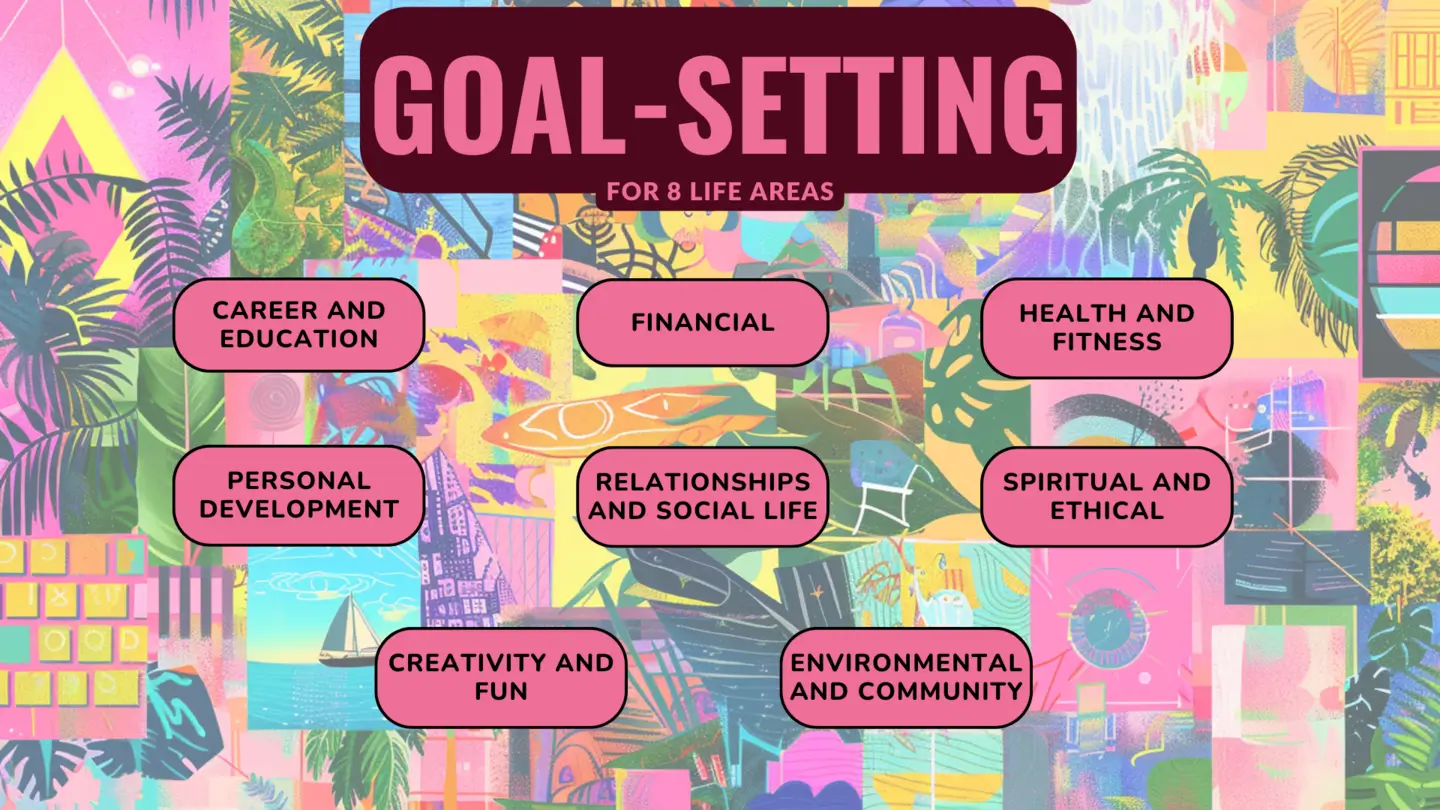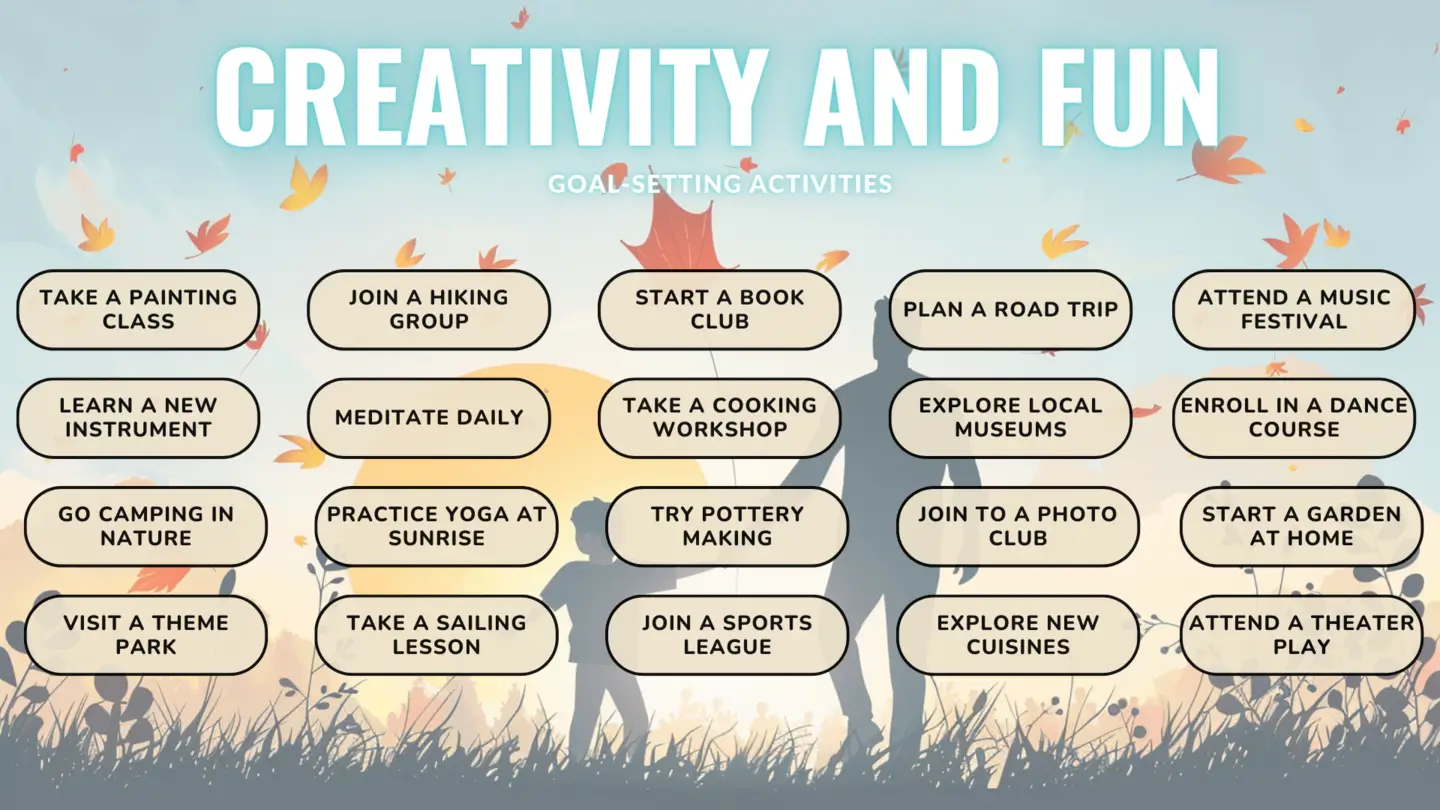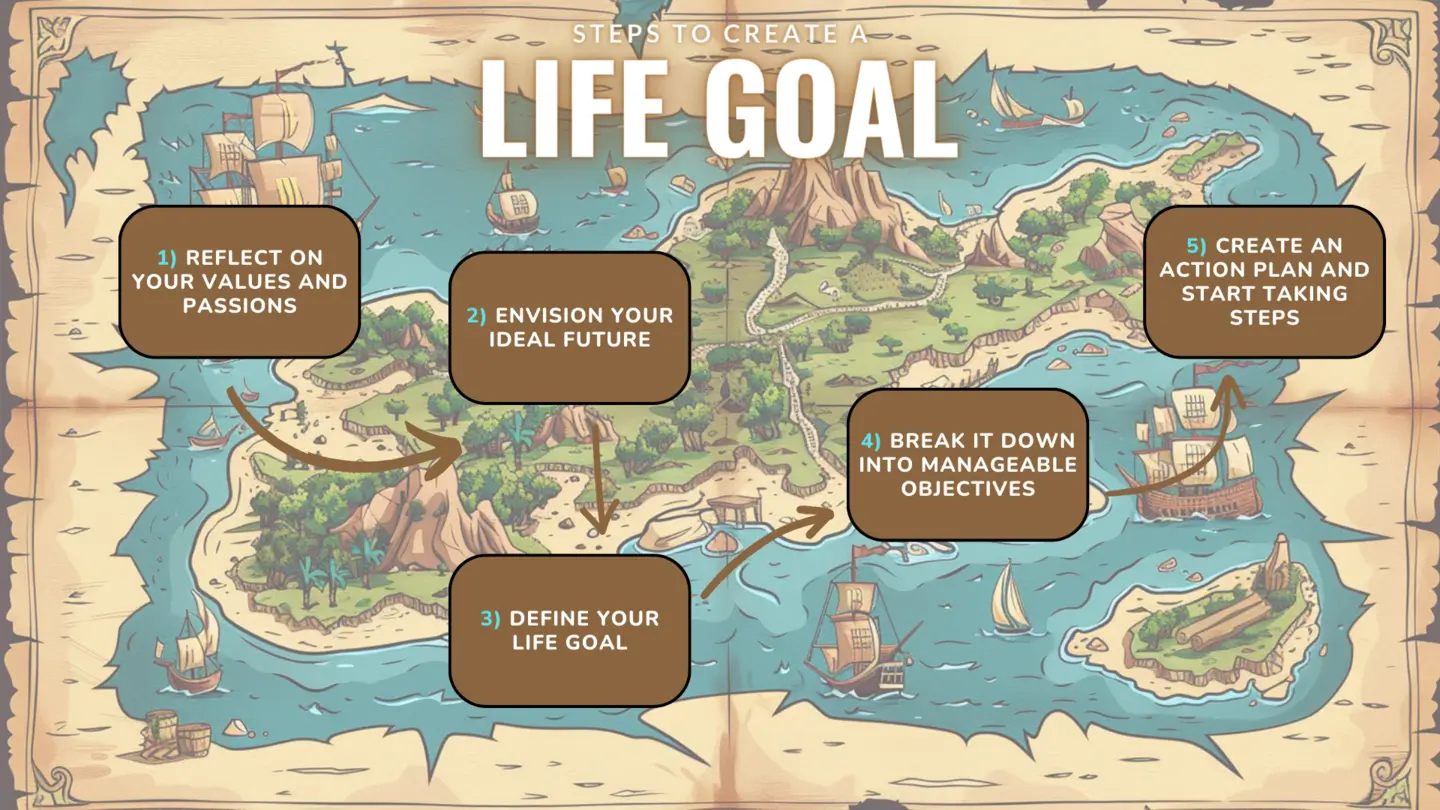Do your days drift by, feeling unfocused and unrewarding? Life without clear goals often leads to a sense of stagnation. You might feel like you’re just going through the motions, without a sense of real progress or accomplishment.
This lack of direction can be frustrating and demotivating. You may start to wonder if you’re truly living your life to the fullest.
Goal-setting is a powerful solution. By defining what you want to achieve across key areas of your life, you create a roadmap that provides focus, motivation, and a thrilling sense of purpose.
Importance of Goal-Setting
Setting goals might seem like a simple exercise, but it’s a superpower!
Goals are like a compass, guiding you through the twists and turns of life. They help you make conscious decisions that align with your desires and move you steadily towards the future you envision.
Without goals, it’s easy to lose focus, drift from task to task, and feel like you’re not truly progressing. Think of your goals as stepping stones across a river – they create a path towards your ultimate destination.

Benefits of Goal-Setting
Setting well-defined goals delivers a multitude of powerful benefits. Here are some of the ways your life can transform:
- Clarity and Focus: Goals cut through the distractions and help you concentrate your energy on what truly matters.
- Increased Productivity: A roadmap of goals helps you use your time and resources most effectively.
- Motivation and Drive: Having a clear target fuels your motivation, inspiring you to persist through challenges.
- Measurable Progress: Goals provide tangible benchmarks, allowing you to track your accomplishments and celebrate the milestones along the way.
- Empowerment and Control: Goals empower you to shape your own destiny, rather than feeling like you’re drifting with the tide.
- Personal Growth: The journey of goal achievement stretches you, helping you to develop new skills and uncover hidden potential.
- Enhanced Self-Confidence: Reaching your goals builds confidence, proving that you are capable of accomplishing great things.
14 percent of people with goals are 10 times more successful than those without goals. (Source: HBR)
10 Goal Setting Examples for All Areas of Life
Goal-setting isn’t just about achieving a single big dream – it’s about creating a fulfilling and well-rounded life. To reach our full potential, it’s important to consider goals in various areas of our lives.
Let’s dive into eight key areas and explore inspiring goal examples to spark your own ideas!

1. Career and Education
Setting goals in your career and education gives you a clear sense of direction, ensuring that your efforts align with your long-term aspirations.
By targeting specific career advancements, such as promotions or a transition into a new field, you position yourself for increased earning potential and greater professional satisfaction.
The act of setting goals in these areas cultivates a mindset of lifelong learning and adaptability, which is essential in keeping up with the evolving demands of the job market.
GOALS EXAMPLES
- Advance to a Leadership Role: “Within two years, I will develop the leadership skills necessary to secure a supervisory position in my department.”
- Become an Industry Expert: “I will actively participate in industry conferences and workshops this year to become a recognized thought leader in my field.”
- Develop a Specialized Skill Set: “I will dedicate 30 minutes each day throughout the next quarter to learning a new software program relevant to my career.”
- Network for New Opportunities: “I will attend two professional networking events per month over the next six months to connect with industry professionals and explore potential career paths.”
- Start a Side Hustle: “I will launch an Etsy shop selling handmade jewelry within the next three months, generating an additional $500 per month.”
- Earn a Degree or Certification: “I will enroll in a part-time online program to complete my bachelor’s degree in Business Administration within three years.”
- Master a New Skill: “I will take a coding bootcamp this summer to learn Python and build a portfolio of web development projects.”
- Improve Public Speaking Skills: “I will join a Toastmasters club to become more comfortable and confident presenting in front of audiences.”
- Learn a New Language: “By using a language-learning app for 30 minutes daily, I will gain conversational fluency in French within a year.”
- Attend Industry Workshops: “I will participate in three relevant industry workshops this year to stay updated on the latest trends and technologies in my field.”
"Education is the most powerful weapon which you can use to change the world."
 Nelson Mandela
Nelson Mandela 2. Financial
Financial goals are like building blocks towards a secure and prosperous future. They provide clarity on how you’ll achieve major milestones—like buying a home, retiring comfortably, or funding your dream vacation.
Setting specific goals in this area helps you stay disciplined, avoid impulsive spending, and prioritize actions that will move you closer to your financial dreams.
Financial goal-setting also fosters a sense of control and can be incredibly motivating as you see yourself making progress towards a better financial life.
GOALS EXAMPLES
- Pay Off Credit Card Debt: “I will pay off my $5,000 credit card balance within 18 months by following a strict debt payoff plan.”
- Eliminate Student Loans: “I will dedicate an extra $300 each month to accelerate my student loan repayment and become debt-free within five years.”
- Build an Emergency Fund: “I will save $3,000 for emergencies within the next year, creating a safety net for unexpected expenses.”
- Save for a Down Payment: “I will create a plan to save $20,000 for a down payment on a house within three years.”
- Start Investing: “I will begin investing by opening a Roth IRA account and contributing $100 per month.”
- Maximize Retirement Contributions: “I will research my options and increase my 401(k) contributions to reach the annual limit.”
- Track Spending: “I will use a budgeting app to track my income and expenses for three months to identify areas where I can cut back.”
- Create a Realistic Budget: “I will design a budget that balances my necessary expenses with my savings and debt repayment goals.”
- Negotiate a Raise: “Within the next six months, I will prepare a list of my accomplishments and ask for a salary increase at my annual performance review.”
- Explore Side Income Streams: “I will create a plan and launch a freelance service in my area of expertise within the next six months.”

3. Health and Fitness
Prioritizing health and fitness goals is an investment in your overall well-being. Regular exercise and healthy habits improve not just your physical appearance, but also your energy levels, mental clarity, and resilience.
Setting goals in this area promotes a sense of accomplishment, combats stress, and helps you live a longer, healthier, and happier life.
"The only person you are destined to become is the person you decide to be."
 Ralph Waldo Emerson
Ralph Waldo Emerson GOALS EXAMPLES
- Increase Physical Activity: “I will commit to 30 minutes of moderate-intensity exercise most days of the week.”
- Train for a Race: “I will register and train for a 5K race over the next three months.”
- Try a New Fitness Class: “I will explore new fitness classes like yoga, Pilates, or Zumba each month until I find one I love.”
- Eat More Whole Foods: “I will gradually incorporate more fruits, vegetables, and whole grains into my daily diet.”
- Cook at Home More Often: “I will aim to cook at home four nights per week to have more control over my meals.”
- Hydrate Consistently: “I will drink eight glasses of water daily for better health and energy levels.”
- Improve Sleep Habits: “I will establish a consistent sleep schedule and aim for 7-8 hours of quality sleep each night.”
- Manage Stress: “I will learn and incorporate stress-management techniques, such as meditation or deep breathing exercises, into my daily routine.”
- Practice Self-Care: “I schedule and dedicate 30 minutes per day to activities that nourish my mind, body, and soul.”
- Quit Smoking: “With appropriate resources and support, I will create a plan to quit smoking within the next six months.”
4. Personal Development
Personal development is all about becoming the best version of yourself. By setting goals in this area, you commit to continuous growth and self-improvement.
It’s your chance to break through limitations, cultivate new skills, strengthen your mindset, and embrace a more fulfilling experience of life.
Personal development goals empower you to live life with greater intention and purpose.
GOALS EXAMPLES
- Boost Self-Confidence: “I will challenge negative self-talk and establish a practice of positive affirmations to increase my self-confidence.”
- Embrace a Growth Mindset: “I will adopt a growth mindset by viewing challenges as opportunities for learning and development.”
- Develop Emotional Intelligence: “I will start reading books and articles to help understand my own emotions and the emotions of others more clearly.”
- Learn a New Skill: “I will identify a skill that interests me (photography, woodworking, etc.) and commit to dedicating time to practicing and improving.”
- Improve Communication Skills: “I will take a public speaking workshop or join a Toastmasters group to enhance my communication skills.”
- Step Outside Your Comfort Zone: “Each month, I will challenge myself to do something that is outside of my comfort zone.”
- Read More Books: “I will commit to reading one non-fiction book per month to expand my knowledge and learn new perspectives.”
- Journal Regularly: “I will incorporate a journaling practice to reflect on my thoughts, emotions, and experiences.”
- Cultivate Gratitude: “I will start a gratitude journal and write down three things I’m grateful for each day.”
- Give Back: “I will find ways to give back to my community by volunteering my time or resources to a cause that I believe in.”
"All progress takes place outside the comfort zone."
 Michael John Bobak
Michael John Bobak 5. Relationships and Social Life
Fostering strong relationships and a vibrant social life is crucial for our well-being and happiness. Setting goals in this area promotes deeper connections, stronger bonds, and a sense of community.
It reminds us to prioritize quality time with loved ones and nurture friendships that support and uplift us.
GOAL EXAMPLES
- Strengthen Existing Relationships: “I will make time for regular phone calls or video chats with long-distance friends and family.”
- Plan Meaningful Activities: “I will schedule at least one quality outing with loved ones each month, such as a hike, dinner, or a game night.”
- Resolve Conflicts: “I will approach any unresolved conflicts in relationships with a willingness to understand and find resolution.”
- Improve Communication: “I will set aside time each week with my partner for meaningful conversations without distractions.”
- Reignite the Spark: “I will plan a romantic date night or a weekend getaway with my partner.”
- Join a Club or Group: “I will join a book club, sports team, or hobby-related group to meet people with common interests.”
- Attend Social Events: “I will challenge myself to attend at least one social event per month to expand my network.”
- Step Out of Your Comfort Zone: “I will try initiating conversations with new people and get to know them better.”
- Practice Self-Love: “I will cultivate self-love by practicing affirmations, taking care of my well-being, and setting healthy boundaries.”
- Say “No” More Often: “I will prioritize my own needs and learn to say ‘no’ to commitments that drain my energy or take me away from my goals.”

6. Spiritual and Ethical
Setting goals in this realm allows you to explore your deeper values, connect with your sense of purpose, and define the guiding principles you want to live by.
Whether you follow a specific faith tradition or have a more personal understanding of spirituality, goals in this area help cultivate inner peace, compassion, and a deep connection with the world around you.
GOALS EXAMPLES
- Develop a Meditation Practice: “I will commit to 10 minutes of daily meditation to increase mindfulness and reduce stress.”
- Explore Different Faith Traditions: “I will visit different places of worship or read books to learn about different spiritual practices.”
- Spend Time in Nature: “I will schedule regular hikes, walks, or outdoor reflections to connect with nature and enhance my spiritual well-being.”
- Practice Forgiveness: “I will make an effort to let go of resentment and focus on forgiveness towards myself and others.”
- Increase Kindness and Compassion: “I will look for small ways to extend kindness to others each day, whether through an act of service, a donation, or a simple smile.”
- Live Mindfully: “I will make conscious choices to align my actions with my values and minimize my negative impact on the environment.”
- Identify Your Core Values: “I will take time for self-reflection to identify my top five core values and ensure my actions are guided by them.”
- Give Back: “I will volunteer my time and support a cause aligned with my personal values.”
- Cultivate Gratitude: “I will start a regular practice of expressing gratitude to others and acknowledging the positive aspects of my life.”
- Find Your Purpose: “I will reflect on my passions, talents, and values to uncover my unique purpose in life.”
7. Creativity and Fun
Creativity and fun may seem less structured than other goal-setting areas, but they are incredibly important to a fulfilling life.
Setting goals in this domain sparks joy, expands your imagination, helps reduce stress, and brings fresh perspectives to your life. It’s about giving yourself permission to play and explore!
GOALS EXAMPLES
- Try a New Creative Hobby: “I will enroll in a beginner’s class for something that sparks my interest, such as painting, pottery, or dancing.”
- Start a Creative Project: “I will dedicate time to starting a creative project I’ve been thinking about, whether it’s writing, music, or any other artistic pursuit.”
- Visit Museums and Art Galleries: “I will schedule visits to local museums and art galleries for inspiration and exposure to different creative works.”
- Schedule “Me Time: “I will carve out dedicated time each week for activities that purely bring me joy and relaxation.”
- Take a Vacation: “I will plan and save for a well-deserved vacation to a destination I’ve always wanted to visit.”
- Try New Experiences: “I will seek out new experiences in my local area, such as festivals, concerts, or trying new restaurants.”
- Play More: “I will add more playfulness to my life, whether it’s playing games, trying new sports, or engaging in silly activities.”
- Embrace Laughter: “I will surround myself with people who make me laugh and actively seek out sources of humor.”
- Reconnect with Old Hobbies: “I will set aside time to revisit a hobby from my childhood that I haven’t enjoyed in a while.”
- Don’t Take Yourself Too Seriously: “I will give myself permission not to be perfect and to simply enjoy the process of exploration and fun.”

8. Environmental and Community
Setting goals in this area allows you to contribute positively to the world around you. It’s about becoming a more conscious citizen, reducing your impact on the environment, and giving back to your local community.
This instills a sense of purpose and connectedness beyond yourself.
GOALS EXAMPLES
- Reduce Waste: “I will make changes to reduce my waste output, such as using reusable bags, avoiding single-use products, and composting food scraps.”
- Conserve Energy and Water: “I will implement practices to conserve energy and water in my daily life, like turning off lights and taking shorter showers.”
- Support Sustainable Businesses: “I will research and choose to support businesses committed to sustainable and ethical practices.”
- Volunteer Your Time: “I will find a local organization that aligns with my interests and volunteer my time regularly.”
- Donate to Causes You Care About: “I will identify and set aside funds to donate to charities or causes close to my heart.”
- Support Local Businesses: “I will make an effort to shop at local businesses and support my community’s economy.”
- Learn About Global Issues: “I will stay informed on pressing global issues like climate change, poverty, and inequality.”
- Minimize Travel Impact: “When I travel, I will research sustainable travel options that minimize my environmental impact. “
- Advocate for Change: “I will use my voice and actions to advocate for changes I want to see in the world, whether it’s contacting representatives or participating in peaceful demonstrations.”
- Lead by Example: “I will strive to live by my values and inspire others to make environmentally conscious and socially responsible choices.”
Set a Life-Goal in 5 Steps
You’ve considered goals in various areas of your life. Now, it’s time to zoom out and think about the overarching direction you want your life to take.
A life goal is like the North Star, guiding you on your path, infusing smaller goals with more meaning, and ensuring everything you do ultimately contributes to the big picture.
Let’s dive into a 5-step process designed to help you define a powerful and inspiring life goal.

Step 1: Reflect on Your Values and Passions
Before defining where you want to go, it’s important to understand who you are and what truly matters to you. Your core values and passions act as an inner compass, pointing you towards a fulfilling and authentic path.
Here’s how to start this reflection:
- Identify Your Values: Consider what principles are most important to you, such as integrity, compassion, adventure, or creativity. Reflect on experiences that brought you joy and satisfaction, or moments where you felt a deep sense of alignment. These clues hint at your core values.
- Explore Your Passions: What sparks excitement within you? Is there a cause you care deeply about? What subjects or activities could you talk about and engage in for hours on end? Think about hobbies or things you’ve always dreamed of doing. These are all windows into your passions.
- Write it Down: Create lists of your values and passions. Don’t worry about making them perfect at this stage – your goal is to get all your ideas out on paper (or in a text document).
People who write down their goals are more likely to be successful than those who have either unwritten goals or no specific goals at all. (Source: Study focuses on strategies for achieving goals, resolutions (dominican.edu))
Key Takeaway: Discovering your values and passions lays the foundation for setting a life goal that’s both fulfilling and aligned with your true self.
Step 2: Envision Your Ideal Future
Now let’s shift into a future-focused mindset. Picture your life 5, 10, or even 20 years down the road. Where do you want to be? What do you want to be doing? Use these prompts to guide your visualization:
- Personal Life: What does your ideal family life or social circle look like? Where are you living? What brings you joy and fulfillment outside of work?
- Career: What type of work aligns with your passion and values? What impact do you want to have? Are you in a leadership role or owning your own business?
- Growth and Development: What new skills or experiences do you want to acquire? How do you see yourself evolving as a person?
- Contributions: How do you want to make a positive impact on your community or the world? What kind of legacy do you hope to leave behind?
Key Takeaway: Let your imagination roam free! Don’t limit yourself by what seems practical right now. The goal is to paint a picture of a future that truly excites and inspires you.
"All our dreams can come true, if we have the courage to pursue them."
 Walt Disney
Walt Disney Step 3: Define Your Life Goal
It’s time to translate your values, passions, and your ideal future vision into a clear and compelling life goal. Here’s how to approach this:
- Look for Themes: Review your reflection notes from steps 1 and 2. Identify recurring themes, desires, and the things you seem most excited about.
- Craft a Concise Statement: Try to distill the essence of your ideal future into a single, powerful sentence. This is your draft life goal.
- Make it SMART: Check if your draft is SMART: Specific, Measurable, Achievable, Relevant, and Time-bound. While some aspects of your life goal can be more open-ended, making it as SMART as possible will help you break it down.
Key Takeaway: Your life goal doesn’t have to be set in stone forever. It’s a guidepost that can evolve as you do. But getting it down on paper is a powerful first step.

Step 4: Break It Down into Manageable Objectives
A big, inspiring life goal can feel overwhelming at first. This step helps you bridge the gap between where you are and where you want to be. Here’s how:
- Identify Milestones: Break down your life goal into smaller milestones or objectives. These could be 1-year goals, 3-year goals, and so on, depending on the scope of your life goal.
- Be Specific: Make each objective as clear and specific as possible. Instead of saying, “Advance my career”, a stronger objective could be, “Earn a promotion to a senior-level position or complete a certification program in my field within two years”.
- Create a Timeline: Assign tentative deadlines to each objective. This doesn’t have to be rigid, but it helps create a sense of direction and urgency.
In 90 percent of the studies, challenging and specific goals resulted in better performance than easy goals, no goals, or “do your best” goals. (Source: APA PsycNet)
Key Takeaway: Breaking down your life goal into smaller objectives makes it feel achievable and creates a roadmap you can follow.
Step 5: Create an Action Plan and Start Taking Steps
It’s time to turn your dream into reality! This step is about creating a plan and translating your objectives into actionable steps.
- Break Down Objectives Further: For each objective, identify the specific actions you need to take. These could be tasks like researching schools, creating a website, or networking with potential collaborators.
- Set Smaller Deadlines: Assign deadlines to individual tasks, breaking them down into monthly or even weekly goals.
- Prioritize: Not all tasks are created equal. Identify the highest priority actions that will have the biggest impact in moving you towards your goals.
- Take the First Step: Pick the very next action you can take, no matter how small, and do it right away! This builds momentum and fights procrastination.
Key Takeaway: Remember, consistency is key. Taking small, focused steps every day will lead to more significant progress than sporadic bursts of activity.
Additional Tips
- Stay Flexible: Revisit and adjust your plan as needed. Life is unpredictable, and flexibility is essential.
- Celebrate Wins: Acknowledge and celebrate your milestones along the way. This will keep you motivated and reinforce your commitment.
Free SMART Goal Generator!
Case Study: Alex Goal-Setting Journey
Alex is a 32-year-old graphic designer feeling unfulfilled in his current job.
He’s always dreamt of traveling the world and having more creative freedom, but feels trapped by financial obligations and a lack of direction. He decides to embark on a goal-setting journey to change his life.
Steps Followed
1. Reflect on Values and Passions
- Alex realizes his core values are freedom, adventure, creativity, and making a positive impact.
- His passions include photography, exploring new cultures, and environmental sustainability.
2. Envision Your Ideal Future
- Alex envisions working remotely, using his creative skills to travel, document his travels, and inspire others to appreciate different cultures and protect the planet.
3. Define Your Life Goal
- Alex’s life goal: “To build a sustainable freelance business combining photography and graphic design, allowing me to travel extensively, share my experiences through visual storytelling, and support environmental conservation projects”.
4. Break It Down into Manageable Objectives
- Year 1: Build a strong portfolio, learn basic business skills, and secure initial freelance clients.
- Year 2: Transition to full-time freelancing, travel for 3 months, and donate a percentage of earnings to an environmental non-profit.
- Year 3: Expand client base, establish himself as a travel/sustainability content creator, and partner with conservation organizations on projects.
5. Create an Action Plan and Start Taking Steps
- Alex breaks down objectives into weekly tasks: updating his portfolio, taking online marketing courses, networking, and pitching to potential clients.
- He prioritizes high-impact actions, sets deadlines, and schedules dedicated work blocks to build his business alongside his day job.
- Alex takes the first step by contacting a travel blogger whose work he admires, offering his design services.
Results
Progress and Challenges
Alex faces setbacks: slow client acquisition, the stress of balancing work, and occasional self-doubt.
However, he celebrates small wins, connects with a supportive online community, and adjusts his plan based on what he learns.
Outcome
After two years of persistent effort, Alex achieves a semi-nomadic lifestyle, building a fulfilling freelance career that allows him to travel and contribute to causes he believes in.

His defined life goal and step-by-step approach were key to transforming his dream into reality.
Final Thoughts
Setting goals is a journey, not a destination.
It’s a powerful practice that allows you to intentionally shape your life experiences.
Remember, your goals may evolve as you do. Be open to revisiting, adjusting and even setting entirely new goals as your priorities or circumstances change.
Next Steps For You
- Choose a Focus Area: Reflect on the eight areas of life we’ve explored. Pick one area to start setting goals in right away.
- Start Small: Don’t feel pressured to create a master plan for your entire life. Begin with one or two small, achievable goals within your chosen area.
- Get Support: Share your goals with supportive friends or family. Consider joining online communities or finding an accountability buddy.
- Take Action: Start with an action you can take today, no matter how small, to move closer to your goals.
”If you’re tired, learn to rest, not quit.”
Quiz Time!
Frequently Asked Questions
How do you set goals in different areas of your life?
Start by identifying the key areas where you want to improve or achieve something important (career, relationships, health, etc.). Within each area, take time for self-reflection.
Ask yourself what brings you fulfillment, what aligns with your values, and what your ideal outcome looks like. Once you have that clarity, define specific, measurable goals.
Break down any big goals into smaller, manageable steps and create an action plan with timelines. Remember, it’s essential to review and adjust your plan along the way.
What are 3 common types of goals?
- Outcome Goals: This type focuses on a specific result you want to achieve, such as earning a promotion or running a 5K race.
- Process Goals: These are about establishing the habits and actions that will lead you to the desired outcome. For example, you might commit to exercising three times a week to support your goal of running a 5K.
- Performance Goals: Performance goals set personal standards or benchmarks you want to meet on a regular basis, for instance, completing a certain amount of work every day or achieving a specific level of customer satisfaction.
What is smart goal setting?
SMART stands for Specific, Measurable, Achievable, Relevant, and Time-bound. It’s a framework that helps you create clear, actionable, and effective goals.
Specific goals are well-defined, measurable goals include ways to track progress, achievable goals are challenging but realistic, relevant goals align with your broader life goals, and time-bound goals have deadlines to keep you on track.
What are realistic goals?
Realistic goals are those you can achieve based on your current skills, resources, and time constraints. They should be challenging enough to motivate you, but not so far-fetched that they feel impossible.
Be honest about your starting point and any limitations when setting timelines. Don’t be afraid to adjust your goals as needed—flexibility is key!




